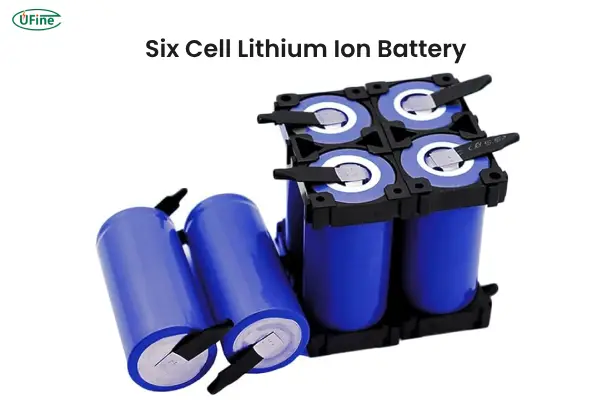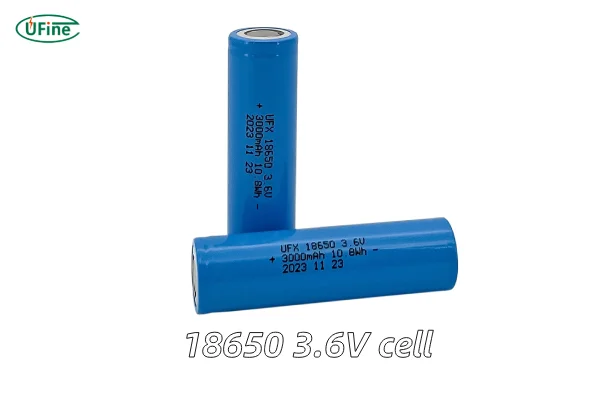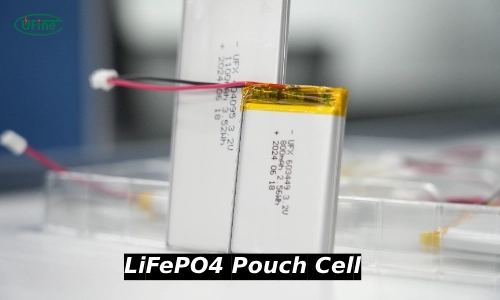Lithium-ion batteries are everywhere. From smartphones to electric vehicles (EVs), we rely on them to keep our devices running smoothly. One of the most common configurations of these batteries is the six-cell lithium-ion battery. Whether you’re a tech enthusiast, a DIYer building a battery pack, or just someone curious about how your gadgets work, understanding the specifics of a six-cell lithium-ion battery is key to maximizing its performance and lifespan.
In this detailed guide, we will break down everything you need to know about these batteries—from their construction and voltage to their lifespan, price, and best maintenance practices.
Part 1. What is a six cell lithium ion battery ?
At its core, a lithium-ion battery six cell is a battery pack made up of six individual lithium-ion cells. These cells work together to provide a specific voltage and capacity, powering devices such as laptops, power tools, and even electric bikes. A lithium-ion battery works by moving lithium ions between two electrodes (an anode and a cathode) during charging and discharging cycles. This flow of ions generates the electric current that powers devices.
The six-cell configuration is typically used in applications where moderate to high voltage is needed. It offers a balance of energy density, power output, and portability. The design is compact yet powerful enough to fuel devices for extended periods.
Advantages of a Lithium Ion Battery Six Cell:
- High Energy Density: Lithium-ion batteries store a lot of energy relative to their size and weight, making them ideal for portable applications.
- Long Lifespan: They last longer than traditional batteries like lead-acid or nickel-cadmium, with hundreds of charge cycles.
- Efficiency: Lithium-ion batteries are more efficient at converting energy, meaning less energy is lost during charging and discharging.
- Lightweight Design: Ideal for devices where space and weight are critical, such as laptops, drones, and power tools.
Part 2. Types of cells in a six-cell lithium ion battery
Understanding the different cell types in a six-cell lithium-ion battery is important because the type of cell used directly affects the battery’s performance, lifespan, and cost. There are several types of cells commonly used in these batteries, each with its unique characteristics.
1️⃣ Cylindrical Cells (18650, 21700, etc.)
Cylindrical cells are the most common type of cell used in a six-cell configuration. These cells are recognizable by their cylindrical shape (hence the name) and are used in devices like laptops, power tools, and electric vehicles.
- Size: The most common cylindrical cells are 18650 (18mm diameter and 65mm length) and 21700 (21mm diameter and 70mm length).
- Voltage: Typically 3.6V – 3.7V per cell, with a full charge voltage of around 4.2V.
- Advantages: Cylindrical cells have excellent thermal management properties, allowing them to operate efficiently even at higher currents. They are also relatively inexpensive and widely available.
- Applications: Laptops, power tools, and larger battery packs like those used in electric vehicles (EVs).
2️⃣ Prismatic Cells
Prismatic cells are flatter than cylindrical cells, which makes them ideal for applications where space is at a premium. These cells are often used in smartphones, tablets, and some laptops.
- Size: Generally rectangular, which allows for a more compact design in devices.
- Voltage: Similar to cylindrical cells, they operate at 3.6V to 3.7V per cell.
- Advantages: Their flat design allows them to fit more easily into small or compact spaces, making them a great choice for mobile devices. They also typically have a higher energy density than cylindrical cells.
- Applications: Mobile phones, laptops, tablets, and wearables.
3️⃣ Pouch Cells
Pouch cells are soft, flexible, and ultra-lightweight, which makes them perfect for electric vehicles (EVs), drones, and high-performance applications.
- Size: Flexible design, can be shaped and resized to fit any available space.
- Voltage: Usually 3.6V – 3.7V per cell.
- Advantages: Pouch cells have the highest energy density and weight-to-energy ratio. They’re especially useful in applications requiring high power output in a lightweight, compact form.
- Applications: Electric vehicles, drones, and high-performance devices.
Part 3. How are 6 li-ion cells connected?
A six-cell lithium-ion battery pack can be connected in various configurations to achieve different voltage and capacity outputs, depending on the specific requirements of the device.
🔹 Series Connection (6S Configuration)
When lithium-ion cells are connected in series, the voltage increases, but the capacity (mAh) remains the same. This is commonly referred to as a 6S configuration, where six cells are linked together in a chain, and the total voltage is the sum of each individual cell’s voltage.
- Example: If each cell provides 3.7V, the total voltage in a 6-cell series connection will be 3.7V × 6 = 22.2V (fully charged voltage: 25.2V).
- Used in: High-power applications such as power tools, electric vehicles, and drones.
🔹 Parallel Connection
In a parallel connection, the voltage remains the same, but the capacity (mAh) increases, meaning the battery can store more energy. For instance, a 3S2P configuration (three cells in series, two cells in parallel) combines voltage and capacity for an optimal balance.
- Example: If three cells are connected in series (3S) to give a voltage of 11.1V, and two sets of cells are connected in parallel (2P), the battery will have the voltage of 11.1V, but the capacity will be doubled.
- Used in: Laptops, electric bikes, and consumer electronics where both voltage and capacity are important.
Part 4. Voltage
The voltage of a six-cell lithium-ion battery is a crucial aspect that determines the power output for devices. The total voltage depends on how the cells are connected (in series or parallel) and their charge level.
- Nominal Voltage: The nominal voltage for a six-cell lithium-ion battery is 22.2V (3.7V × 6 cells), which is the standard operating voltage.
- Fully Charged Voltage: When fully charged, the voltage rises to 25.2V (4.2V × 6 cells), providing the highest power output.
- Fully Discharged Voltage: A fully discharged 6-cell battery typically drops to around 18V (3.0V × 6 cells), which is the cut-off voltage to prevent damage.
The voltage of a six-cell lithium-ion battery directly impacts its power delivery, and this is one reason why batteries are designed with specific configurations for particular devices.
Part 5. Lifespan
The lifespan of a six-cell lithium-ion battery is an important consideration for anyone looking to get the most out of their device. On average, lithium-ion batteries can last anywhere from 300 to 1000 charge cycles. However, several factors influence the actual lifespan of the battery:
Key Factors Affecting Lifespan:
- Depth of Discharge (DoD): Batteries degrade faster when they are consistently discharged to very low levels. Avoid deep discharges (below 20%) to maximize lifespan.
- Charge Cycles: A charge cycle refers to a full discharge and recharge. Frequent partial charges won’t harm the battery as long as the battery isn’t constantly fully discharged.
- Temperature: High temperatures accelerate wear and tear on the battery. Always avoid leaving your battery in hot environments, such as in a car on a sunny day.
- Charging Rate: Fast charging generates more heat, which can reduce the lifespan of the battery. Charging at a slower, more controlled rate is generally better for the health of the battery.
Part 6. Price
The cost of a six-cell lithium-ion battery varies depending on several factors, including brand, cell type, capacity, and application.
- Laptop Batteries: Generally range between $30 to $100, depending on the manufacturer and capacity.
- Power Tool Batteries: Typically cost around $50 to $150, especially for high-drain tools like drills or saws.
- Electric Bike Batteries: These can be more expensive, ranging from $100 to $500 or more, depending on the specific requirements.
- High-Performance Batteries: Custom-made batteries for electric vehicles or industrial use can cost $200 or more.
Part 7. Applications
The six-cell lithium-ion battery is versatile and can be used in a wide variety of applications, thanks to its balanced design and power output. Some of the most common uses include:
- Laptops & Notebooks: Provides reliable, portable power for computing needs.
- Electric Vehicles (EVs): Powers electric bikes, scooters, and even some electric cars.
- Power Tools: Drills, saws, and other cordless tools rely on these batteries for extended use.
- Consumer Electronics: From drones to portable speakers and gaming consoles, lithium-ion batteries are found in most modern devices.
With its ability to deliver high voltage and long-lasting power, the six-cell configuration is especially useful for devices that require a balance of portability and performance.
Part 8. Maintenance tips
To keep your lithium-ion battery six cell performing at its best, proper maintenance is crucial. Here are some tips for prolonging the lifespan of your battery:
- Avoid Full Discharges: Try to keep the charge level between 20% and 80% for optimal longevity.
- Temperature Control: Always keep your battery at room temperature (around 20°C to 25°C). High temperatures will shorten its lifespan.
- Use the Right Charger: Always use a genuine charger designed for your device to avoid damaging the battery with incompatible power.
- Storage: If you’re not using the device for a long period, store it at around 50% charge. Avoid leaving it fully charged or completely drained.
- Regular Use: Batteries last longer when they’re used regularly. If left unused for too long, they can degrade even faster.
By following these practices, you can ensure your six-cell lithium-ion battery continues to perform optimally for years to come.
Part 9. Conclusion
The six-cell lithium-ion battery is a versatile, efficient, and reliable power source for a wide range of applications. From laptops and power tools to electric vehicles, understanding how these batteries work—along with how to properly maintain and manage them—can greatly enhance their performance and lifespan.
Whether you’re considering a new battery for your device or building a custom pack, this guide has given you all the tools and knowledge needed to make the best choice for your needs. By keeping your battery in optimal condition, you’ll ensure it delivers consistent performance for years to come.
Related Tags:
More Articles

Easy Guide: Picking the Right Garden Tractor Battery.
Confused about your garden tractor battery? Find the right battery & keep your lawn tractor running strong! Read more here.
Learn Deep Cycle Battery Charging
Confused about charging deep cycle batteries? Don't be! Our guide breaks down the process. You'll learn the best ways to charge your battery safely.
Battery Array vs. Single Battery: Which Is Right for Your Energy Needs?
Battery array vs. single battery: Learn how they work, their benefits, and which option best suits your energy needs for performance and cost.
What Is a Battery Array?
A battery array is a group of connected batteries ensuring reliable power. This article covers its types, benefits, and key applications.
Growth Trends in the Flexible Thin Film and Printed Battery Market
The flexible thin film and printed battery market is evolving fast. This article covers its growth, innovations, challenges, and future trends.







